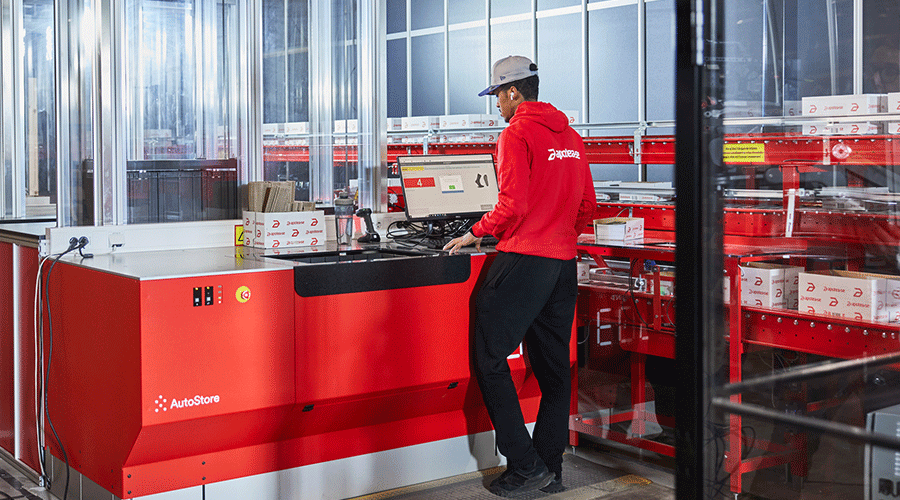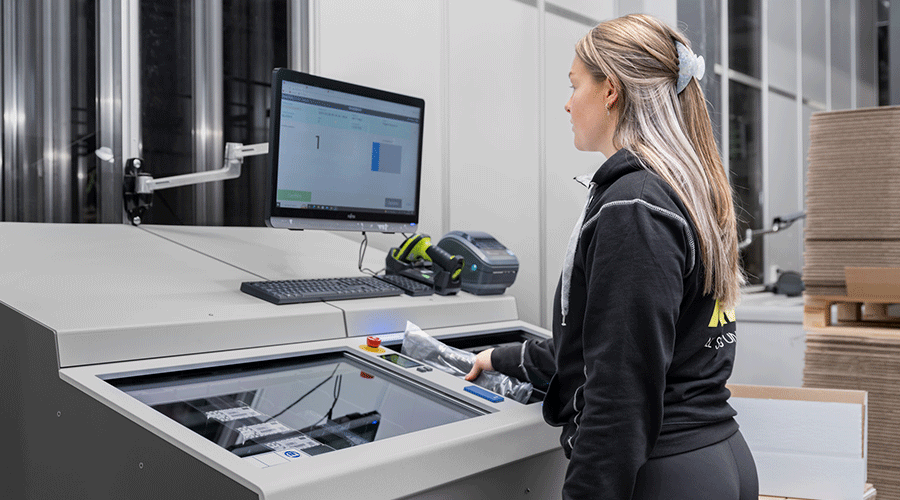Ergonomics in Warehouse Work: A Comprehensive Guide
Ergonomics is critical to retaining talent in modern warehouses, enabling people to be both productive and comfortable at their jobs. Learn how proper equipment and layout promote well-being while supporting compliance with safety standards and regulations.
Warehouses are bustling hubs of activity, where efficiency and safety are paramount. In such a dynamic environment, ergonomics plays a pivotal role in ensuring the well-being of warehouse workers and enhancing operational productivity. In this blog, we will delve into the numerous benefits of ergonomics in warehouse settings, addressing key questions and shedding light on the significance of ergonomic practices.
What are the various types of warehouse equipment?
Before explaining the importance of warehouse ergonomics, it’s important to understand the various types of equipment included in a warehouse, the differences between them, and how they help companies comply with warehouse safety standards and warehouse safety requirements.
Offices and workstations
The primary difference between an office and a workstation is the nature of the work being performed. In an office setting, a workstation refers to an individual's desk, chair, computer, and other office tools. An office is typically a dedicated space for administrative tasks, while a workstation, especially in a warehouse setting, is designed for specific physical tasks like order fulfillment or material handling.
Cubicles and workstations
Cubicles are a type of workstation, but they are semi-enclosed spaces often used in office settings. Workstations can encompass a broader range of setups, from open concept areas to private offices and cubicles.
Industrial workstations
An industrial workstation is a specialized workstation designed for rugged, high-demand environments like warehouses. These workstations are built to withstand heavy use and can often be customized to meet specific ergonomic and functional requirements.
A typical industrial workstation in a warehouse is designed for a specific task, equipped with the necessary tools and equipment, and arranged to minimize strain on the worker. These workstations vary in size and configuration depending on the tasks they support.

Examples of industrial workstations
Industrial workstations in a warehouse can vary depending on the tasks being performed. Common types include picking stations, packing stations, and loading/unloading stations. Each is designed with specific tasks in mind to optimize worker efficiency and comfort. They might be equipped with packing materials, shipping labels, tape dispensers, and a comfortable chair. This setup allows employees to efficiently pack items for shipment.

Why is ergonomics important in a warehouse setting?
Ergonomics is the science of designing and arranging the workplace to fit the worker, not the other way around. In a warehouse setting, this means creating a workspace that optimizes comfort, safety, and efficiency for employees. Proper ergonomics can help prevent workplace injuries, reduce fatigue, and enhance worker well-being.

The importance of ergonomics in a warehouse setting cannot be overstated. It plays a vital role in ensuring the well-being of warehouse workers and enhancing operational productivity. One of the key aspects of ergonomics in a warehouse is the design of adjustable workstations. These workstations are designed to fit the workers and maximize safety, comfort, and productivity.
Workers often need to reach and bend to access items in the warehouse. These actions can lead to fatigue and injuries. Ergonomics addresses this issue by designing equipment to minimize these movements, thus reducing the risk of injuries and enhancing overall comfort.
How can ergonomic practices reduce injuries in warehouses?
Ergonomic practices minimize the risk of workplace injuries by promoting correct posture, reducing physical strain, and providing tools and equipment that are easy to use. This leads to fewer musculoskeletal disorders, slip and fall accidents, and other common warehouse mishaps.

Ergonomic practices in warehouses are geared toward reducing the risk of injuries. Adjustable workstations can help. These workstations are designed to minimize movements that can lead to fatigue and injuries, such as excessive reaching and bending. By creating workspaces that are tailored to the workers and provide the right tools and equipment, ergonomic practices help prevent common warehouse mishaps.
What role does technology play in advancing warehouse ergonomics?
Technology is a crucial driver of warehouse ergonomics. Smart warehouses that use automation, radio-frequency identification (RFID) tracking systems, and ergonomic software applications help streamline operations, reducing the physical demands on workers and enhancing overall efficiency.
Incorporating virtual reality (VR) and augmented reality (AR) into training programs can completely transform the learning process. These technologies immerse employees in various scenarios within a simulated environment, rendering training sessions more engaging, interactive, and enjoyable. Beyond mitigating the risks associated with real-life training, this approach enhances knowledge retention and proficiency acquisition.
Wearable RF devices equipped with finger scanners have the potential to significantly boost efficiency and accuracy in tasks like inventory management and order picking. Likewise, smart glasses harnessing the power of AR and artificial intelligence (AI) provide real-time information and guidance, elevating decision-making and overall productivity.
Exoskeletons offer vital support and reinforcement, ensuring that workers maintain proper body movements and techniques while simultaneously reducing physical strain and the likelihood of injuries. For tasks demanding high levels of innovation, technologies such as robotic process automation (RPA) have the capacity to revolutionize the execution of systematic, repetitive tasks.
What equipment is designed with warehouse ergonomics in mind?
A variety of specialized equipment is designed to enhance ergonomics in warehouses, including adjustable pallet racking systems, ergonomic pallet jacks, conveyor systems, and lift-assist devices. These tools help reduce the physical strain on workers and promote safe and efficient material handling.
AutoStore FusionPort is highly ergonomic. It incorporates features like pick-to-light and intuitive screen interfaces to minimize reaching and stretching, further exemplifying the importance of ergonomic equipment in warehouse operations.
Additionally, the new Port has enough peripheral space for robotic piece picking, more complex workflows, higher throughputs and productivity features to boost accuracy and efficiency.
A 15° forward tilt of the Bin opening decreases the physical strain on employees. Angling the work reduces the need for reach required for employees to pick from the back of a Bin and gives greater visibility of all locations.
Safety hatches cover the workstation. The sliding plexiglass-style door opens once an item is ready to be picked and closed once that transaction is complete. Other ports have safety features included as well, but the hatch provides a more comprehensive safety measure to help reduce workplace accidents and ensure the safety of the operator.
The pick-to-light system is designed to help guide the operator to the correct pick as a light will illuminate the correct Bin location for the operator to pick from. Pick-to-light is designed to simplify the operator workflow, decrease stress while operating the port, reduce errors, and simplify training. The FusionPort pick-to-light minimizes the repetitive need to look at or interact with the Port, furthering the ergonomic benefits.

How does ergonomics impact employee productivity?
Improved ergonomics leads to increased employee productivity. Ergonomically designed workspaces are often more efficient. For example, well-organized tools and equipment are within easy reach, and workflows are optimized for productivity. This streamlines work processes and minimizes wasted time and effort, allowing employees to complete tasks more quickly and with fewer errors.
Ergonomics isn't just about physical comfort but also about creating a conducive environment for cognitive work. Proper lighting, reduced noise, and well-organized workspaces can improve concentration and cognitive performance, leading to better decision-making and problem-solving abilities.
In short, with ergonomic workstations and environments, employees are more likely to stay healthy, engaged, and focused on their tasks, ultimately leading to increased productivity and improved overall performance.
How can warehouses be designed with ergonomics in consideration?
Warehouse design should incorporate ergonomic principles, including proper aisle width, organized storage, and workstations tailored to individual tasks. The layout should prioritize the safety and comfort of employees, reducing the need for excessive bending, lifting, and twisting.
What are the long-term benefits of prioritizing warehouse ergonomics?
Prioritizing ergonomics in warehouses leads to long-term benefits, such as reduced turnover rates, lower worker compensation costs, and improved company reputation. This investment in employee well-being can pay significant dividends in the long run.
How do you train staff on ergonomic practices?
Training on ergonomic practices should be an integral part of onboarding and ongoing employee development. This includes:
- Teaching proper lifting techniques
- Workstation setup
- The importance of taking breaks to prevent fatigue.
- Learning to use equipment, tools, and machines more safely
- Working with proper posture and equipment suited to their physical needs
- Lifting heavy loads properly and safely
- Recognizing symptoms of musculoskeletal disorders and nerve issues
UPS, in collaboration with the Teamsters Union, is an example of how to implement a safety culture. The company spends $343 million annually on training and refers to its employees as “industrial athletes.”
To keep employees productive and healthy, UPS has invested in ergonomic technologies, including AutoStore.
Conclusion
In conclusion, ergonomics is a critical consideration in the warehouse industry. Prioritizing ergonomics not only enhances the well-being of employees but also results in increased productivity, reduced injuries, and long-term benefits for both workers and the organization. By embracing ergonomic principles and utilizing appropriate equipment, warehouses can create safer, more efficient, and worker-friendly environments.
FAQ
What is ergonomics in a warehouse?
Ergonomics in a warehouse refers to the science of designing and arranging the workspace to optimize the interaction between workers and their environment. It aims to enhance worker comfort, safety, and efficiency while reducing the risk of injury or strain.
What are examples of ergonomics in a warehouse?
Examples of ergonomics in a warehouse include:
- Proper shelving and rack heights to minimize bending and reaching
- Use of adjustable workstations and chairs to accommodate various body sizes and tasks
- Ergonomic lifting techniques and equipment like pallet jacks and forklifts
- Anti-fatigue mats to reduce discomfort for workers who stand for extended periods
- Well-designed packing stations and workbenches to promote efficient workflows
- Ergonomically designed tools and equipment that reduce strain on the body
- Proper lighting and ventilation to reduce eye strain and ensure a comfortable working environment
- Adequate training for employees on ergonomic principles and safe work practices
What are ergonomic risk factors in a warehouse?
Ergonomic risk factors in a warehouse are conditions or practices that can lead to discomfort, injury, or long-term health issues for workers. Some common ergonomic risk factors include:
- Repetitive motions, such as lifting, bending, or twisting, which can cause strain over time
- Awkward postures, like reaching too far or working in cramped spaces, which can lead to musculoskeletal issues
- Heavy lifting without proper equipment or techniques, increasing the risk of back injuries
- Inadequate lighting, which can lead to eye strain and make it difficult to see and read label
- Poorly designed workstations and tools that don't match the worker's body size and the task at hand
- Lack of breaks or rest periods, contributing to fatigue and discomfort
- Uncomfortable temperatures or poor ventilation, which can affect overall well-being and focus
What makes a workplace ergonomic?
A workplace is considered ergonomic when it is designed and organized to promote the well-being and productivity of the workers. Key factors that make a workplace ergonomic include:
- Fitting the job to the worker by considering their physical abilities and limitations
- Providing adjustable furniture and equipment that can accommodate different body sizes and tasks
- Minimizing repetitive or strenuous tasks and promoting safe working practices
- Maintaining a clean and organized workspace to prevent tripping hazards
- Ensuring proper lighting, ventilation, and temperature control for a comfortable environment
- Offering training and resources to educate employees about ergonomics and safety
- Regularly assessing and addressing ergonomic issues and making necessary adjustments
An ergonomic workplace aims to reduce the risk of workplace injuries and enhance employee comfort and productivity.











